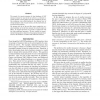Free Online Productivity Tools
i2Speak
i2Symbol
i2OCR
iTex2Img
iWeb2Print
iWeb2Shot
i2Type
iPdf2Split
iPdf2Merge
i2Bopomofo
i2Arabic
i2Style
i2Image
i2PDF
iLatex2Rtf
Sci2ools
AAAI
2008
2008
Measuring the Hardness of SAT Instances
The search of a precise measure of what hardness of SAT instances means for state-of-the-art solvers is a relevant research question. Among others, the space complexity of treelike resolution (also called hardness), the minimal size of strong backdoors and of cycle-cutsets, and the treewidth can be used for this purpose. We propose the use of the tree-like space complexity as a solid candidate to be the best measure for solvers based on DPLL. To support this thesis we provide a comparison with the other mentioned measures. We also conduct an experimental investigation to show how the proposed measure characterizes the hardness of random and industrial instances.
| Added | 02 Oct 2010 |
| Updated | 02 Oct 2010 |
| Type | Conference |
| Year | 2008 |
| Where | AAAI |
| Authors | Carlos Ansótegui, Maria Luisa Bonet, Jordi Levy, Felip Manyà |
Comments (0)

